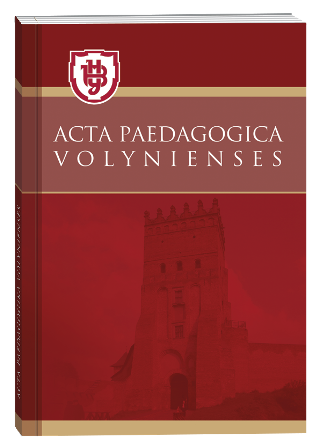DIDACTIC GAME AS A MEANS OF ACQUAINTING CHILDREN WITH THE SUBJECT ENVIRONMENT
DOI:
https://doi.org/10.32782/apv/2021.4.3Keywords:
didactic game, subject environment, preschool children, subject worldAbstract
The article presents the semantic characteristics of the didactic game as a means of acquainting children with the subject environment. This concept is analyzed from the standpoint of different scientific approaches. The essence of didactic game, its functions and structure, stages of carrying out are characterized. Researchers’ views on the classification of didactic games are presented. Acquaintance of preschool children with the subject environment does not involve the transfer of empirical knowledge about the properties and methods of action with objects, and generalized in science and recorded in the system of scientific concepts experience of human knowledge of reality: nature, society, thinking. Mass coverage of children with public preschool education makes it possible to practically ensure continuity and continuity in the educational work of the preschool institution and school. Preschool age is a period of building a child’s basic relationship with the world and his desire to organize their knowledge of the environment, and then generalize them in the form of a certain model of the universe. During the preschool childhood the child has the first ideas about the environment, develops the ability to establish the simplest relationships and patterns in the phenomena of the world, as well as independently apply the acquired knowledge in practice. Acquaintance with the material world plays an important role in forming an individual picture of the child’s world. Objects reveal different aspects of human life: work, life, art. Knowing the objective world, the child learns about the qualities and properties of the world in general: essential and insignificant. Thus, preschool age is a period that plays a special role in the child's knowledge of the world in general, and the material world in particular. In this regard, it is important to find a fundamentally new content, teaching methods, for independent activity, will promote the development of cognitive and practical activity, will develop the beginnings of creativity.
References
Артемова Л.В. Окружающий мир в дидактических играх дошкольников : книга для воспитателей дет. сада и родителей. Москва, 1992. 96 с.
Базовий компонент дошкільної освіти: за станом на 4 травня 2012 р. / Міністерство освіти і науки, молоді та спорту України. Київ : Видавництво, 2012. 26 с.
Богуш А. Методика ознайомлення дітей з довкіллям у дошкільному навчальному закладі. Підручник для ВНЗ / А. Богуш, Н. Гавриш. Київ : Видавничий Дім «Слово», 2008. 408 с.
Бондаренко А.К. Дидактические игры в детском саду : книга для воспитателя детского сада. Москва, 1991. 160 с.
Дыбина О.В. Рукотворный мир: Игры – занятия для дошкольников. Москва, 2011. 128 с.
Дыбина-Артамонова О.В. Предметный мир как источник познания социальной действительности. Самара, 1997. 136 с.
Зайцева Л.І. Знання про об’єкти довкілля як засіб розвитку початків обдарованості дитини-дошкільника. Освіта та розвиток обдарованої особистості. 2014. № 5 (24). С. 29–35.
Кисленко В.Я. Психологические особенности усвоения правил обращения с предметами детьми раннего и дошкольного возраста. Москва, 1981. С. 49–56.
Логинова В.И. Формирование системности знаний у детей дошкольного возраста. Ленинград, 1984. 174 с.
Крухлет М.В. Ребенок познает предметный мир. Дошкольное воспитание. 2007. № 1. С. 45–47.







